Visconti of Milan
The Visconti of Milan are a noble Italian family. They rose to power in Milan during the Middle Ages where they ruled from 1277 to 1447, initially as lords then as dukes, and several collateral branches still exist. The effective founder of the Visconti lordship of Milan was the archbishop Ottone, who wrested control of the city from the rival Della Torre family in 1277.[1]
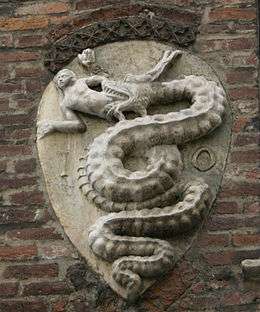
| Visconti Vicecomes | |
|---|---|
.svg.png) Coat of arms of the Visconti of Milan | |
| Etymology | vice: "deputy" - comes: "count" |
| Founded | 1075 |
| Founder | Ariprando Visconti |
| Final ruler | Filippo Maria Visconti |
| Titles | Lord of Milan (1277–1395) Duke of Milan (1395–1447) |
| Motto | Vipereos mores non violabo (Latin for "I will not violate the customs of the serpent") |
| Cadet branches | Visconti di Modrone |
Origins
The earliest members of the Visconti lineage appeared in Milan in the second half of the 11th century. The first evidence is on October 5, 1075, when "Ariprandus Vicecomes" and "Otto Vicecomes filius Ariprandi" attended and signed together some legal documents in Milan.[2] The family of Ariprando Visconti and his son Ottone is believed to have pre-existed in Milan and to have obtained the title of viscount, which then became hereditary throughout the male descent.[3][4]
In the years following 1075, Ottone Visconti is shown in the proximity of the sovereigns of the Salian dynasty, Henry IV and his son Conrad. This relationship is confirmed by the circumstances of his death, which occurred in Rome in 1111, when he was slaughtered after an attempt to defend Henry V from an assault.[lower-alpha 1][lower-alpha 2][7] In the first documents where they appear, Ottone and his offspring declared that they abided by the Lombard law and acted in connection with other Milanese families of the noble upper class (capitanei).[8] A relationship with the Litta, a Milanese vavasour family subordinate to the Visconti in the feudal hierarchy, is also documented.[9][10] These circumstances make evident their participation to the Milanese society in the years before 1075 and ultimately their Lombard origin.[11]
In 1134, Guido Visconti, son of Ottone, received from the abbot of Saint Gall the investiture of the court of Massino[12], a strategic location on the hills above Lake Maggiore, near Arona, where another family member was present in the second half of the 12th century as a castellan (custos) of the local archiepiscopal fortress.[13] In 1142, the investiture was confirmed by the King Conrad III, in a diploma released to Guido in Ulm.[14] Another royal diploma, issued by Conrad III in 1142 as well, attests the entitlement of the Visconti to the fodrum in Albusciago and Besnate.[15] On the basis of a document from the year 1157, the Visconti were considered holders of the captaincy of Marliano (today Mariano Comense) since the time of the archbishop Landulf;[16] however, the available documentation cannot infer such conclusion.[17]
A second Ottone, son of Guido, is attested in the documentary sources between the years 1134 and 1192. The primary role of Ottone in the political life of the Milanese commune emerges in the period of the confrontation with Frederick Barbarossa: his name is the first to be cited, March 1, 1162, in the group of Milanese leaders surrendering to the emperor after the capitulation of the city that took place in the previous weeks.[18][19] A member of the following generation, Ariprando was bishop of Vercelli between 1208 and 1213, when he played also the role of Papal legate for Innocent III. An attempt to have him elected archbishop of Milan failed in 1212 amidst growing tensions between opposite factions inside the city. His death, in 1213, was probably caused by poisoning.[20]
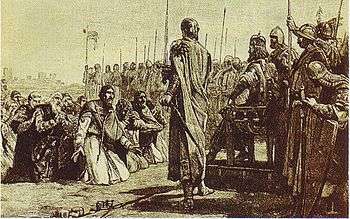
The family dispersed into several branches, some of which were entrusted fiefs far off from the Lombard metropolis. Among them, the one originating the Medieval lords of Milan allegedly descended from Uberto, who died in the first half of the 13th century.[21] The members of the other branches frequently added to their surname the name of the place where they chose to live and where a castle was available for their residence. The first of such cases were the Visconti of Massino, the Visconti of Invorio and the Visconti of Oleggio Castello.[22] In these localities the castle (Massino), its remains (Invorio) or a later reconstruction of the initial building (Oleggio Castello) are still today visible.
Lords and Dukes of Milan
The Visconti ruled Milan until the early Renaissance, first as Lords, then, from 1395, with the mighty Gian Galeazzo who endeavored to unify Northern Italy and Tuscany, as Dukes. Visconti rule in Milan ended with the death of Filippo Maria Visconti in 1447. He was succeeded by a short-lived republic and then by his son-in-law Francesco I Sforza, who established the reign of the House of Sforza.[23][24]
Rise to the lordship
With the death of Frederick II in 1250 and the ceasing of the war of the Lombard League against him, which itself was a reason for the Milanese commune to be united in its defence, a period of conflicts between rivaling factions began inside the city. The Della Torre family progressively acquired power in Milan after 1240, when Pagano Della Torre assumed the leadership of the Credenza di Sant'Ambrogio, a political party with a popular base. This allowed them to have a role in the tax collection of the commune (estimo), which was essential to finance the war against Frederick II while affecting the great landowners. In 1247 Pagano was succeeded by his nephew Martino Della Torre. To underline the preeminence of his position, the new role of Senior of the Credenza (Anziano della Credenza) was created. In this position the Della Torre began to be confronted with the Milanese noble families organized in their own political party, the Societas Capitaneorum et Valvassorum, having the Visconti among the most prominent figures. After a period of unrest between the opposite parties, in 1258 the so-called Sant'Ambrogio Peace was signed among the parties, strengthening the position of La Credenza and La Motta (a second political party with popular tendencies).[25][26]
The peace was undermined by new events in favour of the Della Torre. At the end of 1259, Oberto Pallavicino, a former partisan of Frederick II who got closer to the Guelph positions of the Della Torre, was appointed by the Milanese commune for five years in the role of General Captain of the People. Pallavicino's position in Milan was greatly enhanced by the victory he obtained in the Battle of Cassano on 16 September 1259, against Ezzelino da Romano, formerly his ally on the Ghibelline side in the war against Milan, the Lombard League and the Papacy. In Ezzelino the noble expelled from Milan during the clashes preceding the Sant'Ambrogio Peace placed their hopes to get back in the city to their old power. In 1264, when Pallavicino left his office (preparing another change of alliance), Martino Della Torre remained the sole ruler of Milan and de facto its Lord.[27][28][29] A decisive event in the confrontation between the Della Torre and the Visconti factions was the appointment of Ottone Visconti to archbishop of Milan in 1262. Ottone was preferred by Pope Urban IV to Raimondo, another candidate member of the Della Torre family. Prevented from assuming his office and forced by the opposite faction to remain outside the city, Ottone tried to settle in Arona, at the border of the Milanese archdiocese. At the end of 1263, Della Torre forces with the support of Oberto Pallavicino dislodged him from Arona. Ottone sought refuge in central Italy near the pope. The Della Torre party under the guidance of Filippo Della Torre, brother of Martino and his successor after 1263, took advantage also of the favour of Charles of Anjou. Milan forged an alliance with him and with other northern Italian cities (Guelph League) to fight the Hohenstaufen rule in southern Italy. Francesco Della Torre led the Milanese expedition in southern Italy, which ended in 1266 with the allied victory against Manfred of Sicily in the Battle of Benevento. Charles of Anjou became the new King of Sicily, having also an indirect rule (exercised through the Della Torre) on Milan.[30]
Trying to take advantage from the favourable moment, in 1266 the Della Torre made an attempt to advocate their cause against the Visconti in a consistory held by Pope Clement IV in Viterbo and attended by the archbishop Ottone. Despite the presence of a delegate of Charles of Anjou the decision of the pope was in favour of Ottone. An attempt was then made by the Pope to appease the Milanese factions by means of an oath of allegiance demanded to the Milanese population. Part of it was the acceptance of Ottone as archbishop. The events however were changed again by new circumstances in favour of the Della Torre. At the end of 1266 in Germany was taken the decision to support Conradin, the last member of the Hohenstaufen dynasty, in an attempt to recover the domains in southern Italy lost after the defeat of Benevento and the death of Manfred of Sicily. This reinstated again the Della Torre in their position of leaders of the Guelph League. Moreover, in 1268, Clement IV died, initiating a period of papal vacancy that left without practical consequences the dispositions in favour of Ottone.[31]
After the definitive end of the Hohenstaufen threat (Conradin was defeated and executed in Naples in 1268), the confrontation between the two Milanese factions assumed more and more a military connotation. A leading figure on the Visconti side was Simone Orelli da Locarno, whose military ability became legendary during the wars against Fredrick II. Notwithstanding this, being in favour of the Visconti, he was arrested in 1263 and jailed in Milan. In 1276 he was freed in the context of a compromise between the two factions about Como and after his promise of not acting against the Della Torre. He joined altogether the Visconti army assuming the role of General Captain. The Visconti forces took progressively advantage in the area of Lake Maggiore. In 1276 Tebaldo Visconti, nephew of Ottone, was captured with other leading figures of the Visconti forces. Brought to Gallarate, they were executed by beheading. The Visconti eventually defeated the Della Torre army in the decisive Battle of Desio on 27 January 1277, opening the way for Ottone to enter in Milan. Napoleone, son of Pagano, was arrested with other Della Torre family members. He died in jail few months later. These events are generally considered to mark the foundation of the Visconti lordship on Milan.[32][33]
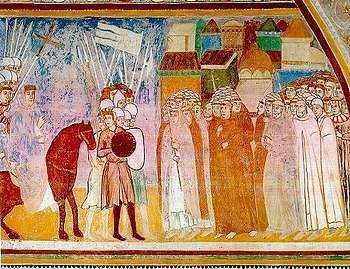
Ottone initially granted power in Milan to Simone Orelli, appointing him Captain of the People. In 1287, he transferred this role to his grandnephew Matteo Visconti (the son of Tebaldo executed in 1277), who one year later obtained also the title of Imperial vicar from the emperor Rudolf of Habsburg. Ottone died in 1295, leaving Matteo Lord of Milan. In 1302, the Della Torre took again the power, forcing Matteo to leave the city. After an intervention of Henry VII, appeasing the dispute between the two families, the lordship of the Visconti on Milan was definitely restored in 1311.[34][35][33]
Rulers and their families
Matteo, Galeazzo, Azzone, Luchino and Giovanni (1311–1354)
The reconciliation agreement with the Della Torre, reached in the December 1310 on the initiative of Henry VII, was attended by Matteo, his brother Uberto and their cousin Ludovico, also known as Lodrisio.[36] In the following years Matteo acted alone as Lord of Milan and after him the authority on the city and on a growing territory in northern and central Italy was assumed by seven members of his offspring along four generations. Matteo ruled for about eleven years, providing to his family the legal basis for the hereditary lordship on Milan and extending the territory under Milanese influence against the traditional opponents of the Visconti: the Della Torre and Anjou dynasties allied with the Papacy. After being accused of necromancy and heresy, he was convicted by the Church. Looking for a reconciliation, he transferred the power to his eldest son Galeazzo and left Milan for the Augustinian monastery of Crescenzago, where he died in 1322.[37]
After Matteo's death, Galeazzo associated his brothers Marco, Luchino, Stefano, and Giovanni (a cleric) in the controls of the inherited domains. He died five years later, succeeded by his son Azzone, who ruled between 1329 and 1339. Stefano, married to Valentina Doria from Genoa, died in 1327 under unclear circumstances. He left three children: Matteo (Matteo II), Bernabò and Galeazzo (Galeazzo II). Marco felt in disgrace and was killed by hitmen in 1329. The deaths of two brothers restricted the future successions to Luchino, Giovanni (since 1342 archbishop of Milan) and the three sons of Stefano.[38]
During Azzone's rule, Lodrisio (the cousin of Matteo who in 1310 attended the reconciliation with the Della Torre) raised against him trying to revert the line of succession in favour of his own family. He obtained the support of the Della Scala family of Verona, but in 1339, in the Battle of Parabiago, he was defeated by an army led by Azzone and backed by his uncles Luchino and Giovanni. When Azzone died, in 1339, the young age of his sons motivated the transfer of the power to his uncle Luchino, who ruled until his death in 1349. During this period the three sons of Stefano were suspected of a conspiracy against him. The archbishop Giovanni sent them away from Milan, saving them from the possible violent reaction of Luchino.[39]
After the death of Luchino, the power was transferred to Giovanni. Under his rule the territorial expansion continued (to Genoa and Bologna) as a result of his diplomacy. Part of his initiatives were the marriages of the sons of Stefano to members of the nearby noble dynasties of northern Italy: in 1340 Matteo II to Egidiola Gonzaga, in 1350 Bernabò to Regina Della Scala and Galeazzo II to Bianca of Savoy.[40][41] In 1353 Petrarch accepted an invitation of Giovanni and moved to Milan, where he lived until 1361. He took part to the diplomatic initiatives of the Visconti, providing in his letters first-hand accounts of his life in Milan and of Visconti family events.[42]
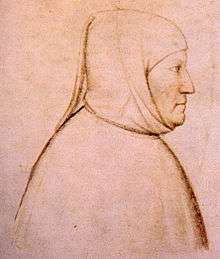
Joint lordship of Matteo II, Bernabò and Galeazzo II (1354–1385)
On 5 October 1354 the archbishop Giovanni died. In his honour, few days after, Petrach held a commemorative oration.[43] In the same month the three sons of Stefano agreed to share the power, dividing the Visconti domains according to geographic criteria. Matteo II died the following year and his territory was divided between Bernabò and Galeazzo II. The two brothers settled their courts separately: Bernabò in Milan, Galeazzo II in Pavia.[44][45] Through the marriages of their sons and daughters, Bernabò and Galeazzo II extended the Visconti relationships to a number of other European noble dynasties.
In 1360 Gian Galeazzo, the eldest son of Galeazzo II, married Isabelle of Valois, daughter of King John II of France. The marriage was the result of negotiation participated also by Petrarch with a journey to Paris[46] and leading the Visconti to contribute with 600,000 francs to the ransom paid by France to England to obtain the freedom of the King in an episode of the Hundred Years' War.[47][48] Violante, the eldest daughter of Galeazzo II, married in 1368 Lionel of Antwerp Duke of Clarence, third son of King Edward III of England. After her husband's death, only few months after the marriage, in 1377 Violante married Secondotto, Marquess of Montferrat. Remained again widow, in 1381 she married her cousin Lodovico, one of the sons of Bernabò.[49][50]
Bernabò and his wife Regina Della Scala had 15 children. Nine daughters (Taddea, Viridis, Valentina, Agnese, Antonia, Maddalena, Anglesia, Lucia, Elisabetta) married scions of other European dynasties, connecting the Visconti to the houses of Wittelsbach (Taddea, Maddalena, Elisabetta), Habsburg (Viridis), Poitiers-Lusignan (Valentina, Anglesia), Württemberg (Antonia), Gonzaga (Agnese), Kent (Lucia). Their sons Marco and Carlo married respectively Elisabeth of Bavaria and Beatrice of Armagnac. Caterina, another daughter of Bernabò, married in 1380 her cousin Gian Galeazzo, widow of Isabelle of Valois, who died in 1373 in Pavia while giving birth to her fourth child.[51]
When Galeazzo II died in 1378, his son Gian Galeazzo was the only heir of his half of the Visconti territories. Bernabò, being 28 years older than his nephew, tended to assume a leading role towards him. The two Visconti had different personalities and ruling styles: instinctive, bad tempered and establisher of a terror regime Bernabò; circumspect and relatively mild to his subjects Gian Galeazzo. In the following years the relationship between the two Visconti progressively deteriorated.[52][53]
Few months after the death of his wife and counselor, Bernabò was deposed by his nephew in a coup, probably prepared for years and kept secret. On 5 May 1385, accompanied by his generals (Jacopo dal Verme, Antonio Porro and Guglielmo Bevilacqua) and with a heavy armed escort, Gian Galeazzo moved from Pavia for an apparent pilgrimage journey to Santa Maria del Monte di Velate near Varese. The following day, passing by Milan, he arranged to meet Bernabò for what was expected to be a familiar greeting. Bernabò, unprotected, was intercepted and arrested. The coup led also to the arrest of two sons of Bernabò, who were accompanying him.
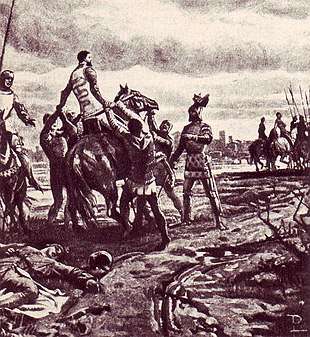
The people living in the domains of Bernabò, firstly the Milanese, promptly submitted to Gian Galeazzo, an attitude widely attributed to their desire to abandon the ruthless regime under which they had been living. Incarcerated in his own castle at Trezzo sull'Adda, Bernabò died few months later after being submitted a poisoned meal.[54][55]
Gian Galeazzo, sole ruler and Duke of Milan (1385–1402)
The death of Bernabò left Gian Galeazzo the sole ruler of the Visconti territories. The sons of Bernabò arrested with him (Ludovico and Rodolfo) spent the rest of their life in jail; the two still free (Carlo and Mastino) lived far from Milan and never posed a threat to Gian Galeazzo. Only the Della Scala in Verona, the family of their mother, continued to support them, but they ended their life in exile, in Bavaria and in Venice, after having reached some agreement with their cousin. The younger and unmarried daughters of Bernabò (Anglesia, Lucia, Elisabetta) continued their life in Pavia under the care of their sister Caterina, the second wife of Gian Galeazzo, until their wedding.[56][57]
For his court, Gian Galeazzo preferred Pavia to Milan. There he continued to develop the renowned library of the castle and to support the local university. The relationship between Gian Galeazzo and the French royal family, interrupted by the death of his first wife Isabelle, was revived by their daughter Valentina, who married in 1389 Louis I, Duke of Orléans, brother of Charles VI, King of France. The three sons of Gian Galeazzo and Isabelle died before reaching adulthood.[58][59]
Gian Galeazzo and Caterina had two sons: Giovanni Maria in 1388 and Filippo Maria in 1392. In 1395 Gian Galeazzo obtained from the Emperor Wenceslaus IV of Bohemia, for the price of 100,000 florins, the title of Duke of Milan. During the years of his rule, the Visconti domains reached the greatest territorial extension in northern and central Italy. Of all the domains of the previous years only Genoa, ruled by the archbishop Giovanni, remained excluded. After a short disease, the plague or the gout, Gian Galeazzo died on 3 September 1402.[60][61]
Giovanni Maria and Filippo Maria (1402–1447)
The difficulties posed to the Visconti court by the unexpected death of Gian Galeazzo is revealed by the secrecy under which the news of his end was kept. The funeral was held a couple of months after his death. The two sons, being only 12 and 10 years old, remained under the care of their mother Caterina. A Council of Regency with a leading role of Facino Cane, one of the generals of Gian Galeazzo, was set up, but contrasts soon emerged inside it. In 1404 Giovanni Maria formally assumed power. Ruling under the influence of Facino Cane, he forced his mother to leave Milan for Monza. There, she ended in the hands of two of the illegitimate sons of Bernabò, who probably caused her death.[62][63]
With Giovanni Maria a period of political crisis began. The policy of Facino Cane, who for himself obtained the title of Count of Biandrate, favoured the local powers and led to the fragmentation of the territorial unity. Peripheral regions were lost to nearby powers. This situation ended in 1412 with the death of Facino Cane. Few months later a conspiracy against Giovanni Maria ended his reign and life. In the same year, his brother Filippo Maria married the widow of Facino Cane, the 42-year-old Beatrice of Tenda, taking advantage of a testamentary disposition in favour of any Visconti that would have married her. The marriage ended with the accusation of adultery to Beatrice, her incarceration and the sentence to death, carried out in the Binasco castle in 1418.[64]
In 1428 Filippo Maria secondly married Mary of Savoy, but they never had sons. In 1425 his mistress Agnese Del Maino gave birth to an illegitimate daughter, Bianca Maria. Considered by his father his only heir, she grew up with her mother in the Abbiategrasso and Cusago castles.[65] In 1432 Bianca Maria was betrothed to Francesco Sforza, a condottiero of Filippo Maria. In 1441 she married him, granting him the succession of the Duchy of Milan. A sign of their marriage is visible today in the twin churches of Santa Maria Incoronata in Milan.[66]
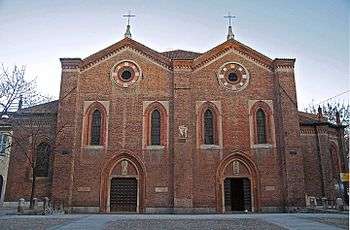
The heirs of Bianca Maria and Valentina, dukes of Milan (1450–1535)
After the death of Filippo Maria in 1447 and the short-lived Ambrosian Republic, in 1450 Francesco Sforza became the new Duke of Milan. Bianca Maria and her husband initiated a new dynasty that ruled Milan discontinuously until 1535.[67]
When Louis XII of France entered Milan in 1499 after the First Italian War, he leveraged on a clause of the marriage contract of his grandmother Valentina, the daughter of Gian Galeazzo, and assumed the title of Duke of Milan. After his death and the short rule of Maximilian Sforza (1512–1515), the Duchy was inherited by his cousin Francis I. After France was defeated by an Imperial-Spanish army in the Battle of Pavia in 1525, the rule on Milan was assumed again by a Sforza, Francesco II. His death and a new war led the Duchy of Milan in the hands of Philip II of Spain, bringing to an end the line of succession initiated by Ottone and Matteo Visconti.
Political developments and territorial hegemony of Milan
Under the rule of the Visconti, the government of the city of Milan underwent profound transformations while its territorial hegemony greatly extended, to suffer a crisis after the death of Gian Galeazzo.
The lordship of Ottone and Matteo brought to an end the confrontation between noble and popular parties, which had assumed growing violent forms in Milan during the 13th century. The new power of the Visconti relied initially on the combined roles of Archbishop (Ottone) and Captain of the People, along with the authority deriving from the title of Imperial Vicar (Matteo). After Matteo, the rule in the city assumed hereditary nature inside his family, making unnecessary any formal recognition by the communal institutions. The first Visconti claimed an absolute power (plenitudo potestatis) comparable to the one preserved to pope and emperor,[68][69] culminating with Bernabò, who openly considered their authorities irrelevant in his dominions.[70] The political change in Milan was part of the general decline of the Commune and the subsequent rise of the Signoria that affected northern and central Italy along the 13th and 14th centuries.[71]
The annexation of the properties of the Milanese church, which included fortifications like the Angera and Arona castles guarding the Lake Maggiore, was the first step taken by Matteo Visconti to consolidate his power in the territory of the Milanese diocese. This originated a conflict with the Papacy that lasted along the following decades.[72][73] The expansion of the Visconti rule outside the Milanese diocese took advantage of the traditional importance of Milan in northern Italy, reinforced by the leading role played in the Lombard League during the wars against the Hohenstaufen emperors.[74] After the destructions inflicted by Frederick Barbarossa in 1162, in few years the Milanese reconstructed their city and defeated the emperor at Legnano in 1176, forcing him to the Peace of Constance, which granted autonomy also to the cities allied to Milan. The war was resumed against Frederick II and his successors, leading eventually to the end of the Hohenstaufen dynasty.[75][76] On the basis of this favorable position, after the death of Henry VII in 1313, Matteo and his son Galeazzo managed to become lords of other cities in northern Italy: Bergamo, Tortona, Alessandria, Vercelli, Piacenza. Regimes in favour of the Visconti were installed in Como, Novara and Pavia. During this first expansion phase, the Visconti continued to face the opposition of the Guelph League: the Papacy, the Anjou house (sovereigns in southern Italy) and the Della Torre family.[77][78]
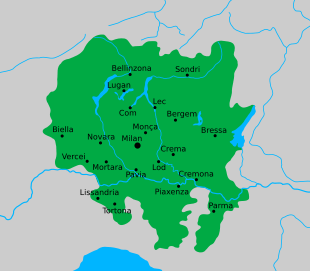
After a crisis suffered during the years of Galeazzo I, the expansion continued under the lordship of Azzone with the military support of his uncle Luchino. In 1334 Cremona surrendered to Azzone. In 1337 Luchino entered in Brescia, allowing Azzone to become Lord of the city. In 1339 Azzone and Luchino defeated in the battle of Parabiago an army formed by their cousin Lodrisio Visconti and the Della Scala family, lords of Verona. In 1341, under the lordship of Luchino, a reconciliation with the Church was reached. In 1346 Luchino took Parma and in 1347 he extended the western border of the Visconti dominions along a stretch of land until Mondovì and Cuneo, at the foot of the Western Alps.[79][80][81]
After the death of Luchino, the archbishop Giovanni further extended the territories under Milanese control. In 1350 he obtained Bologna from the Pepoli family and in 1353 he accepted the lordship of Genoa. Through the marriages of his nephews (Matteo II, Bernabò and Galeazzo II), he linked dynastically the Visconti to the families ruling the territories to the west and east of the Visconti dominions: the Gonzaga, the Della Scala and the Savoy. The acquisition of Bologna, a city belonging to the territory of the Papal States, reopened the conflict with the pope. In 1352, negotiation with the papal envoy, the abbot Guillaume de Grimoard (later Pope Urban V), led to an agreement that allowed Giovanni to continue to rule on Bologna as papal vicar.[82][83][84][85]
The death of the archbishop Giovanni in 1354 and the transfer of power to Bernabò and Galeazzo II were followed by a reaction in Genoa and Bologna. In 1356 Genoa regained its independence. In Bologna, the rebellion of Giovanni Visconti di Oleggio, a former protégée of the Archbishop Giovanni and his lieutenant in the city, opened the way to the intervention of the Cardinal Albornoz, who in 1360 brought back the city within the Papal States. Bernabò, ruler of the eastern portion of the Visconti dominions, tried repeatedly to recover Bologna. This, among other disputes with the Church, cost him a sentence of excommunication by Pope Innocent VI. After his defeat in the Battle of San Ruffillo in 1361, Bernabò finally came to term with the loss of Bologna.[86][87] Bernabò and Galeazzo II engaged bitter clashes also with the imperial authority. After the marquess of Monferrato was appointed imperial vicar in Pavia by Charles IV, the relationship between the emperor and the Visconti deteriorated. In November 1356, in the Battle of Casorate, Visconti forces under the command of Lodrisio Visconti (now reconciled with his cousins) defeated an imperial army and captured its commander, Marquard of Randeck. In 1359, Pavia definitely surrendered to Galeazzo II.[88][89] His decision to erect a vast castle in Pavia and to establish there his court was a sign of the ambition of the Visconti to extend their dominions to the area of the ancient Lombard Kingdom.
In the 1370s, Bernabò and Galeazzo II emerged without severe consequences from manifold simultaneous attacks. The two brothers were deprived by the emperor of their vicariate and condemned by the Pope Gregory XI as heretics. They subsequently suffered military incursions from the eastern border (by the count of Savoy) and from Bologna (by Papal-Florentine forces), which ended without significant impacts. A peace with the pope and a reconciliation with the count of Savoy followed, while Florence turned against the pope in a new war.[90][91] The years of Bernabò and Galeazzo II were marked also by the extension of their matrimonial policies. The marriages of their daughters and sons connected the Visconti to the elite of the European aristocracy: the French and English royal houses and a number of German noble families.[92]
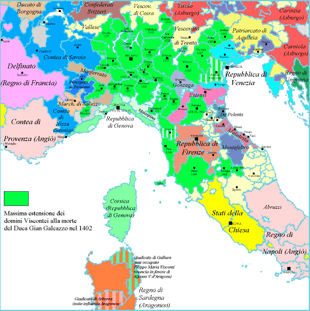
The absence of internal conflicts that followed the arrest of Bernabò in 1385 and the ineffectiveness of the policies of both Empire and Papacy against the Visconti reinvigorated their expansion policy. Military and diplomatic initiatives were continuously taken and personally conducted by Gian Galeazzo from his castle in Pavia. A military campaign between 1386 and 1388 ended with the conquest of the Della Scala and Da Carrara territories of Verona and Padua.[93] Between 1390 and 1398 the attacks of Gian Galeazzo encountered the opposition of the local powers of northern and central Italy; wars against Florence and Mantua were ineffective and even led to the loss of Padua.[94] In 1399, without the use force, Gian Galeazzo took possession of Pisa and Siena, followed by Perugia in 1400.[95] In July 1402, after the victory in the Battle of Casalecchio against a Bolognese-Florentine army, he assumed the rule of Bologna.[96] His sudden death, in September 1402, prevented the long foreseen attack to Florence to take place.[97][98]
Gian Galeazzo accompanied the territorial expansion with reforms of the administration (creation of the Consiglio Segreto and the Consiglio di Giustizia), revenues (Maestri delle Entrate) and criminal justice (Capitano di Giustizia). The promotion to the rank of Duke converted Milan and its territory (between Ticino and the Adda rivers) into a duchy.[99] The deep crisis that resulted after the death of Gian Galeazzo is attributed to the lack of time required to secure the power on the rapidly grown dominions.[73] The territorial unity of the Visconti state was heavily affected and the Council of Regency, created to overcome the young age of Gian Galeazzo's sons, could not stem the dividing forces that resurfaced, causing the collapse of the system of government built by him.[100][101] Filippo Maria restored the basis of the Visconti state and the marriage of his daughter Bianca Maria to Francesco Sforza paved the way to a renewed strong government.[102] In the course of the 15th century, however, the territory under Milanese control narrowed to the Duchy of Milan and later never regained the extension reached under the Visconti rule.[103] In the 16th century, the absolute power established by the Visconti was finally abandoned by Francesco II, the last Sforza duke.[104]
Family tree
| Uberto Visconti [1][23][24][21] *? †1248 | |||||||||||||||||||||||||||||||||||||||||||||||||||||||
| Azzone[lower-alpha 3] *? †? | Andreotto *? †? | Ottone[lower-alpha 4] *1207 †1295 | Obizzo[lower-alpha 5] *? †? | ||||||||||||||||||||||||||||||||||||||||||||||||||||
| Teobaldo *1230 †1276 | |||||||||||||||||||||||||||||||||||||||||||||||||||||||
| Matteo I[lower-alpha 6] *1250 †1322 | Uberto *1280? †1315 | ||||||||||||||||||||||||||||||||||||||||||||||||||||||
| Galeazzo[lower-alpha 7] *1277 †1328 | Marco *? †1329 | Luchino[lower-alpha 8] *1287 †1349 | Stefano *1288 †1327 | Giovanni[lower-alpha 9] *1290 †1354 | |||||||||||||||||||||||||||||||||||||||||||||||||||
| Azzone[lower-alpha 10] *1302 †1339 | Luchino *? †1399 | Matteo II[lower-alpha 11] *1319 †1355 | Galeazzo II[lower-alpha 12] *1320? †1378 | Bernabò[lower-alpha 13] *1323 †1385 | |||||||||||||||||||||||||||||||||||||||||||||||||||
| Gian Galeazzo[lower-alpha 14] *1351 †1402 | |||||||||||||||||||||||||||||||||||||||||||||||||||||||
| Louis I, Duke of Orléans *1372†1407 | Valentina[lower-alpha 15] *1371†1408 | Giovanni Maria[lower-alpha 16] *1388 †1412 | Filippo Maria[lower-alpha 17] *1392 †1447 | ||||||||||||||||||||||||||||||||||||||||||||||||||||
| House of Valois-Orléans[lower-alpha 18] | Bianca Maria[lower-alpha 19] *1425 †1468 | Francesco Sforza *1401 †1466 | |||||||||||||||||||||||||||||||||||||||||||||||||||||
| House of Sforza[lower-alpha 20] | |||||||||||||||||||||||||||||||||||||||||||||||||||||||
Cadet branches
Family branches have been continuously originating since the appearance in Milan of the surname Visconti in the year 1075.[106]
During the first generations, the firstborn among brothers is supposed to have received the role of the most important member in the house. The family of the archbishop Ottone and his grandnephew Matteo, first lords of Milan in the second half of the 13th century, are accordingly considered the descendants of the first Ariprando Visconti along an agnatic primogeniture line over about two centuries.[107] The younger brothers gave origin to cadet branches that continued to live in Milan, participating in the political life of the Milanese Commune.[108]
Vergante branches (since the 12th century)
In 1134, Guido Visconti (one of the members of the primogeniture line) obtained from the abbot of Saint Gall the castle of Massino located in the Vergante region on the hills overlooking the Lake Maggiore.[109]
The firstborn of Guido Visconti, Ottone, is attested in Milan in the second half of the 12th century with important roles in the public life of the Milanese commune. His other descendants initiated to live in the Vergante, originating the cadet branches of the Visconti di Massino, the Visconti di Invorio, and the Visconti di Oleggio Castello.[110] To the Visconti di Massino belonged Uberto Pico, who happened to be confused with Uberto Visconti, the brother of Matteo Lord of Milan.[111] A prominent member of the Visconti di Oleggio Castello was Giovanni, Lord of Bologna (1355–1360) and Fermo. He had been wrongly considered an illegitimate son of the archbishop Giovanni Visconti.[112]
Descendants of Pietro (since the 13th century)
From Ottone, son of Guido Visconti, descended the family of the archbishop Ottone and his nephew Tebaldo, executed in 1276 by the opposite faction supporting the Della Torre family.[113] After the death of Tebaldo, a division of the family inheritance took place in 1288 between his sons (Matteo and Uberto) and Pietro (another nephew of the archbishop Ottone). The object of the division was the lands and castles located between the Lake Maggiore and Gallarate (a long-established area of Visconti possessions), the family compound in the center of Milan and other properties. To Pietro went the territories near Gallarate, fortified with castles scattered on the local hills, to Matteo and Uberto the remaining parts.[114]
Among the descendants of Pietro, other divisions followed: first between his sons, Lodrisio and Gaspare; a generation later among his grandchildren. The members of their offspring added to their surnames the names of the inherited lands. From the sons of Lodrisio (Ambrogio, Estorolo) originated the Visconti di Crenna and the Visconti di Besnate; from the sons of Gaspare (Azzo, Antonio, and Giovanni) the Visconti di Jerago, the Visconti di Orago, and the Visconti di Fontaneto. These branches extinguished in the following centuries. Their castles and lands were subsequently transferred to other families.[115]
Descendants of Uberto, brother of Matteo (since the 14th century)
A generation after the separation of the lands assigned to Pietro, another division followed between Matteo and Uberto, the sons of Tebaldo. Uberto (c. 1280–1315) received the castles of Cislago and Somma Lombardo with the lands subject to them.[116] Vercellino, the firstborn of Uberto, was Podestà of Vercelli (1317) and Novara (1318-1320).
From Vercellino, in the 15th century, descended Giambattista Visconti.[117] In 1473, after his death, the castle of Somma Lombardo was divided between his sons, Francesco and Guido.[118] The offspring of Francesco and Guido became known by the surname of Visconti di Somma. Several branches originated from them: among the descendants of Francesco, the Visconti di San Vito and the Visconti della Motta;[119] from Guido, the Visconti di Modrone and the Visconti di Cislago.[120]
Visconti di San Vito
A descendant of Francesco Visconti di Somma in the 17th century was Francesco Maria. In 1629, he received from the King of Spain the title of Marquess of San Vito. From him originated the Visconti di San Vito branch.[119]
Between the 19th and the 20th centuries, the Visconti di San Vito reunited the property of the castle of Somma Lombardo, fragmented after the division of 1473. The Visconti di San Vito extinguished in 1998. The castle of Somma was left to a foundation bearing their name and later open to the public.[121]
Visconti di Modrone
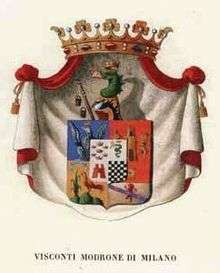
From the descendants of Guido Visconti di Somma, came the lateral branch of the Visconti di Modrone (marquesses of Vimodrone since 1694, later Dukes of Vimodrone since 1813).[120] To this family belonged the film directors Luchino Visconti di Modrone and Eriprando Visconti di Modrone. Luchino was one of the most prominent directors of the Italian neorealist cinema.
Other members
- Federico Visconti (1617–1693), Cardinal and Archbishop of Milan from 1681 to 1693.
- Filippo Maria Visconti (archbishop) (1721–1801), Archbishop of Milan from 1784 to 1801.
- Gaspare Visconti, Archbishop of Milan from 1584 to 1595.
- Roberto Visconti, Archbishop of Milan from 1354 to 1361.
Notes
- "Otto autem Mediolanensis vicecomes cum multis pugnatoribus eiusdem regis in ipsa strage coruit in mortem, amarissimam hominibus diligentibus civitatem Mediolanensium et ecclesiam."[5]
- "Hoc ubi Otto comes Mediolanensis perspexit, pro imperatore se ad mortem obiciens, equum suum contradidit; nec mora, a Romanis captus, et in Urbem inductus, minutatim concisus est, eiusque carnes in platea canibus devorandae relictae."[6]
- Bishop of Ventimiglia (1251 - 1262).
- Archbishop of Milan (1262), lord of Milan (1277-78) and (1282-85).
- Console di giustizia in Milan (1236)).
- Capitano del popolo of Milan (1287–1298), lord of Milan (1287–1302, 1311–1322).[105]
- Lord of Milan (1322–1327).[105]
- Lord of Milan (1339–1349).[105]
- Archbishop of Milan (1339), lord of Milan (1339–1354),[105] lord of Bologna and Genoa (1331–1354).
- Lord of Milan (1329–1339).[105]
- Lord of Milan (1354–1355).[105]
- Lord of Milan (1354–1378).[105]
- Lord of Milan (1354–1385).[105]
- Lord of Milan (1378–1395) and Duke of Milan (1395–1402).[105]
- By the first wife, Isabelle of Valois; grandmother of Louis XII of France, who conquered Milan as her heir.
- By the second wife, Caterina Visconti; duke of Milan (1402–1412).[105]
- By the second wife, Caterina Visconti; duke of Milan (1412–1447).[105]
- Dukes of Milan: Louis XII (1499–1500, 1500–1512), Francis I (1515–1521).[105]
- Illegitimate, by Agnese del Maino; in 1441 married to Francesco I Sforza, later duke of Milan.
- Dukes of Milan: Francesco I (1450–1466), Galeazzo Maria (1466–1476), Giangaleazzo (1466–1476), Ludovico il Moro (1494–1499, 1500), Massimiliano (1512–1515), Francesco II (1521–1535).[105]
References
Citations
- Tolfo, Maria Grazia; Colussi, Paolo (February 7, 2006). "Storia di Milano: I Visconti" [History of Milan: The Visconti]. Storia di Milano (in Italian). Milano. Retrieved September 16, 2010.
- Vittani & Manaresi (1969), docc. 557–560
- Biscaro (1911), pp. 20–24
- Filippini (2014), pp. 33–42
- Bethmann & Jaffé (1868), p. 31, rr. 33-35
- Wattenbach (1846), p. 780, rr. 37–40
- Filippini (2014), pp. 44–45, 83
- Filippini (2014), pp. 85–90
- Keller (1979), p. 207
- Filippini (2014), pp. 90–98
- Keller (1979), pp. 206-207, 364-365
- Hausmann (1969), doc. 21
- Filippini (2014), p. 61
- Filippini (2014), pp. 58–65
- Hausmann (1969), doc. 20
- Biscaro (1911), p. 28
- Filippini (2014), pp. 73–74
- Filippini (2014), pp. 100–101
- Morena & Morena (1994), p. 152
- Filippini (2014), pp. 105–113
- Visconti (1967), p. 275
- Filippini (2014), pp. 62–63
- Hale (1981), p. 338–341, 352
- Williams (1998), p. 33–35
- Cognasso (2014), pp. 33–45
- Menant (2005), p. 67
- Cognasso (2014), pp. 45–51
- Menant (2005), pp. 111–112
- Jones (1997), pp. 520–521
- Cognasso (2014), pp. 56–62
- Cognasso (2014), pp. 64–67
- Cognasso (2014), pp. 67–71
- Jones (1997), p. 619
- Cognasso (2014), pp. 87–100, 109–124
- Menant (2005), pp. 117–118
- Cognasso (2014), pp. 109–114
- Cognasso (2014), pp. 125–131, 142–146, 152
- Cognasso (2014), pp. 152–154, 163–164, 173–174
- Cognasso (2014), pp. 189–190, 191–192, 207–210
- Cognasso (2014), pp. 208, 210–213
- Bueno de Mesquita (1941), pp. 6–7
- Wilkins (1958)
- Wilkins (1958), pp. 75–76
- Cognasso (2014), pp. 208, 235–236, 240
- Bueno de Mesquita (1941), pp. 8–9
- Wilkins (1958), pp. 219–225
- Cognasso (2014), pp. 208, 255–256
- Bueno de Mesquita (1941), p. 10
- Cognasso (2014), pp. 256, 263
- Bueno de Mesquita (1941), pp. 12–13
- Cognasso (2014), pp. 292–293, 283–284, 333–334
- Cognasso (2014), pp. 284–285
- Bueno de Mesquita (1941), pp. 13–14
- Cognasso (2014), pp. 289–302
- Bueno de Mesquita (1941), pp. 31–34
- Cognasso (2014), pp. 333–334, 338
- Bueno de Mesquita (1941), pp. 144, 171
- Cognasso (2014), pp. 325–326, 368–371
- Bueno de Mesquita (1941), pp. 63–68, 79–80, 105
- Cognasso (2014), pp. 3119–3323, 379–380
- Bueno de Mesquita (1941), pp. 173–175, 297–298
- Cognasso (2014), pp. 382–395
- Bueno de Mesquita (1941), pp. 298–301
- Cognasso (2014), pp. 397–414, 415–416
- Cognasso (2014), pp. 452–453, 457
- Cognasso (2014), pp. 457, 484–486
- Cognasso (2014), pp. 528–540, 541–547
- Black (2009), pp. 38–56
- Gamberini (2014), pp. 21–23
- Black (2009), pp. 52–53
- Jones (1997), pp. 152–650
- Cognasso (2014), p. 132
- Gamberini (2014), p. 24
- Gamberini (2014), pp. 19–20
- Jones (1997), pp. 335–358
- Menant (2005), pp. 17–22, 47–52
- Cognasso (2014), pp. 132–168
- Gamberini (2014), pp. 28–29
- Cognasso (2014), pp. 191–205
- Black (2009), pp. 38–42
- Gamberini (2014), p. 39
- Bueno de Mesquita (1941), pp. 6–7
- Black (2009), pp. 42–43
- Cognasso (2014), pp. 207–234
- Gamberini (2014), p. 30
- Cognasso (2014), pp. 239–240, 248–253
- Black (2009), pp. 51–52
- Bueno de Mesquita (1941), pp. 7–8
- Cognasso (2014), pp. 241–244
- Bueno de Mesquita (1941), pp. 8–9
- Black (2009), pp. 52–54
- Gamberini (2014), pp. 30-31
- Bueno de Mesquita (1941), pp. 69–83
- Bueno de Mesquita (1941), pp. 121–136, 206–223
- Bueno de Mesquita (1941), pp. 239–258
- Bueno de Mesquita (1941), pp. 272–280
- Bueno de Mesquita (1941), pp. 281–301, 305
- Gamberini (2014), p. 31
- Black (2009), pp. 68–72
- Bueno de Mesquita (1941), pp. 301–304
- Black (2009), pp. 72–73
- Black (2009), pp. 73–93
- Gamberini (2014), pp. 34–37
- Black (2009), pp. 182–198
- Black (2009), p. xiii
- Litta Biumi (1819–1884)
- Filippini (2014), pp. 83–85, 187
- Filippini (2014), pp. 98–104, 187
- Filippini (2014), pp. 58–61
- Filippini (2014), pp. 61–65, 98–101
- Filippini (2014), p. 17
- Simeoni (1937)
- Cognasso (2014), p. 71
- Litta Biumi (1819–1884), tavola X
- Litta Biumi (1819–1884), tavola X–XI
- Litta Biumi (1819–1884), tavola XIV
- Litta Biumi (1819–1884), tavola XVI
- Grisoni & Bertacchi (2014), p. 56
- Litta Biumi (1819–1884), tavola XVI
- Litta Biumi (1819–1884), tavola XVII
- Grisoni & Bertacchi (2014), pp. 62–63
Primary sources
- Vittani, Giovanni; Manaresi, Cesare, eds. (1969) [1933]. Gli atti privati milanesi e comaschi del sec. XI [The private acts of the Milanese and the Como in the 11th century]. Bibliotheca historica italica (in Italian). 6. Milano: Castello Sforzesco. OCLC 63137745.CS1 maint: ref=harv (link)
- Bethmann, Ludwig; Jaffé, Philipp, eds. (1868). Landulfi de Sancto Paolo Historia Mediolanensis [Landulf of Saint Paul's "History of Milan"]. Monumenta Germaniae Historica, Scriptores (in folio) (in Latin). 20. Hannover: MGH. pp. 17–49.CS1 maint: ref=harv (link)
- Wattenbach, Wilhelm, ed. (1846). Leonis Marsicani et Petri Diaconi Chronica Monasterii Casinensis [Leo Marsicanus and Peter the Deacon's "Montecassino Chronicle"]. Monumenta Germaniae Historica, Scriptores (in folio) (in Latin). 7. Hannover: MGH. pp. 727–844.CS1 maint: ref=harv (link)
- Hausmann, Friedrich, ed. (1969). Die Urkunden Konrads III. und seines Sohnes Heinrich [The documents of Conrad III and his son Henry]. Monumenta Germaniae historica (in Latin). Wien, Köln, Graz: H. Böhlaus Nachf. OCLC 1081868191.CS1 maint: ref=harv (link)
- Morena, Otto; Morena, Acerbo (1994) [1930]. Güterbock, Ferdinand (ed.). Das geschichtswerk des Otto Morena und seiner fortsetzer über die taten Friedrichs I, in der Lombardei [The historical work of Otto Morena and his son on the deeds of Frederick I in Lombardy] (in Latin). Munchen: Monumenta Germaniae Historica. ISBN 9783921575369. OCLC 43984534, 824246002. Retrieved 2019-05-15.CS1 maint: ref=harv (link)
Secondary sources
- Biscaro, Gerolamo (1911). I maggiori dei Visconti signori di Milano [The greatest of the Visconti lords of Milan] (in Italian). Milano: Tip. editrice L.F. Cogliati. hdl:2027/coo.31924030929925. OCLC 866859003.CS1 maint: ref=harv (link)
- Black, Jane (2009). Absolutism in Renaissance Milan. Plenitude of power under the Visconti and the Sforza 1329–1535. Oxford: Oxford University Press. ISBN 9780199565290.CS1 maint: ref=harv (link)
- Bueno de Mesquita, Daniel Meredith (1941). Giangaleazzo Visconti, Duke of Milan (1351-1402): a study in the political career of an Italian despot. Cambridge: Cambridge University Press. ISBN 9780521234559. OCLC 837985673.CS1 maint: ref=harv (link)
- Cognasso, Francesco (2014). I Visconti. Storia di una famiglia [The Visconti. History of a family] (in Italian) (2 ed.). Odaya. ISBN 9788862883061.CS1 maint: ref=harv (link)
- Filippini, Ambrogio (2014). I Visconti di Milano nei secoli XI e XII. Indagini tra le fonti [The Visconti of Milan in the 11th and 12th centuries. Researching the sources] (in Italian). Tangram Edizioni Scientifiche. ISBN 9788864580968.CS1 maint: ref=harv (link)
- Grisoni, Michela M.; Bertacchi, Cristina (2014). "Three castles in one: Castello Visconti di San Vito, Somma Lombardo (Varese)". In Villoresi, Valerio (ed.). Lombard villas and stately homes. Turin: AdArte. pp. 56–71. ISBN 9788889082546.CS1 maint: ref=harv (link)
- Hale, John Rigby (1981). A concise encyclopaedia of the Italian Renaissance. Thames & Hudson. OCLC 636355191.CS1 maint: ref=harv (link)
- Gamberini, Andrea (2014). "Milan and Lombardy in the era of the Visconti and the Sforza". In Gamberini, Andrea (ed.). A companion to late medieval and early modern Milan. The distinctive features of an Italian state. Leiden, Boston: Brill. pp. 19–45. ISBN 9789004284128.CS1 maint: ref=harv (link)
- Jones, Philip James (1997). The Italian city-state from commune to signoria. Oxford & New York: Clarendon Press. ISBN 9786610806577. OCLC 252653924.CS1 maint: ref=harv (link)
- Keller, Hagen (1979). Adelsherrschaft und städtische Gesellschaft in Oberitalien, 9. bis 12. Jahrhundert [Nobility and urban society in northern Italy, 9th to 12th centuries] (in German). 52. Tübingen: M. Niemeyer Verlag. ISBN 9783484800885. OCLC 612442612.CS1 maint: ref=harv (link)
- Litta Biumi, Pompeo (1819–1884). Visconti di Milano. Famiglie celebri italiane (in Italian). Milano: Luciano Basadonna Editore. OCLC 777242652. Retrieved 2020-04-15.CS1 maint: ref=harv (link)
- Menant, François (2005). L'Italie des communes (1100–1350) [Italy of the communes] (in French). Édition Belin. ISBN 9782701140445.CS1 maint: ref=harv (link)
- Simeoni, Luigi (1937). "Visconti da Oleggio". Enciclopedia Italiana di Scienze, Lettere ed Arti (in Italian). Istituto dell'Enciclopedia Italiana. Retrieved 12 April 2020.CS1 maint: ref=harv (link)
- Visconti, Alessandro (1967). Storia di Milano. A cura della Famiglia Meneghina e sotto gli auspici del Comune di Milano [History of Milan. Edited by Famiglia Meneghina and under the auspices of the Commune of Milan] (in Italian). Milano: Ceschina. OCLC 2872335.CS1 maint: ref=harv (link)
- Wilkins, Ernest Hatch (1958). Petrarch's eight years in Milan. Cambridge, MA, US: Mediaeval Academy of America. hdl:2027/heb.31117. OCLC 926390871.CS1 maint: ref=harv (link)
- Williams, George L. (1998). Papal genealogy: The families and descendants of the popes. Jefferson, NC: McFarland. ISBN 9780786403158. OCLC 301275208. Retrieved September 16, 2010.CS1 maint: ref=harv (link)